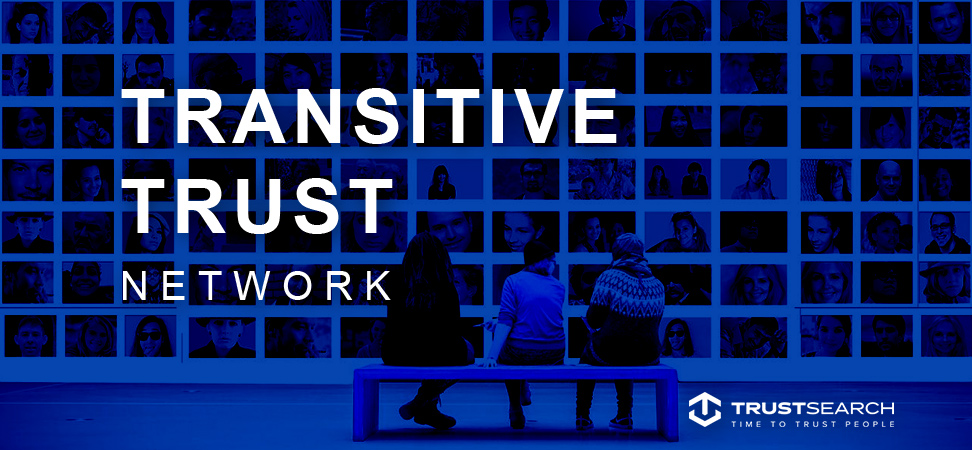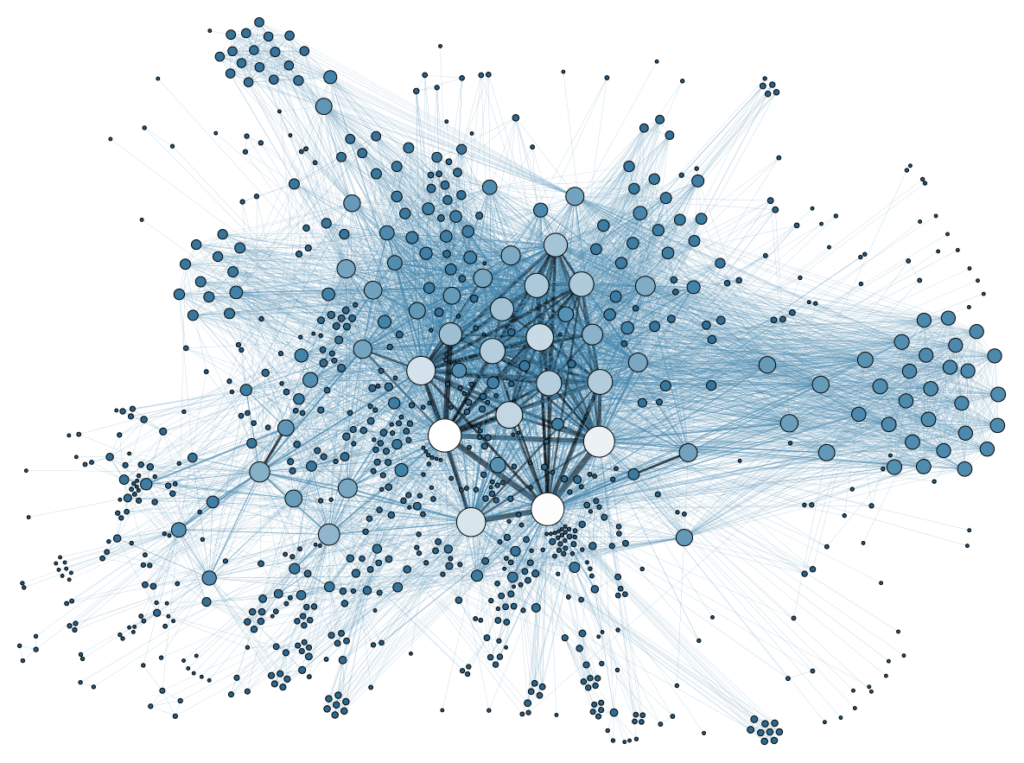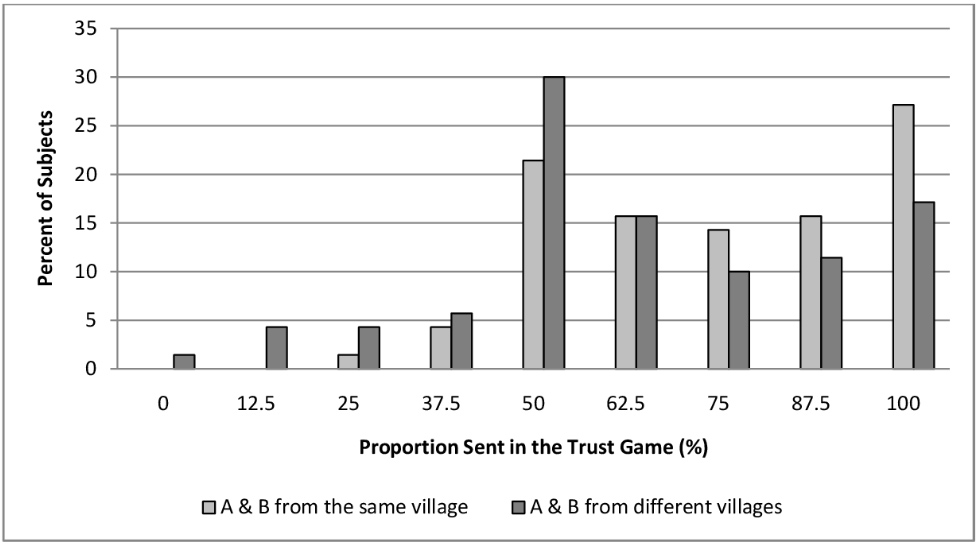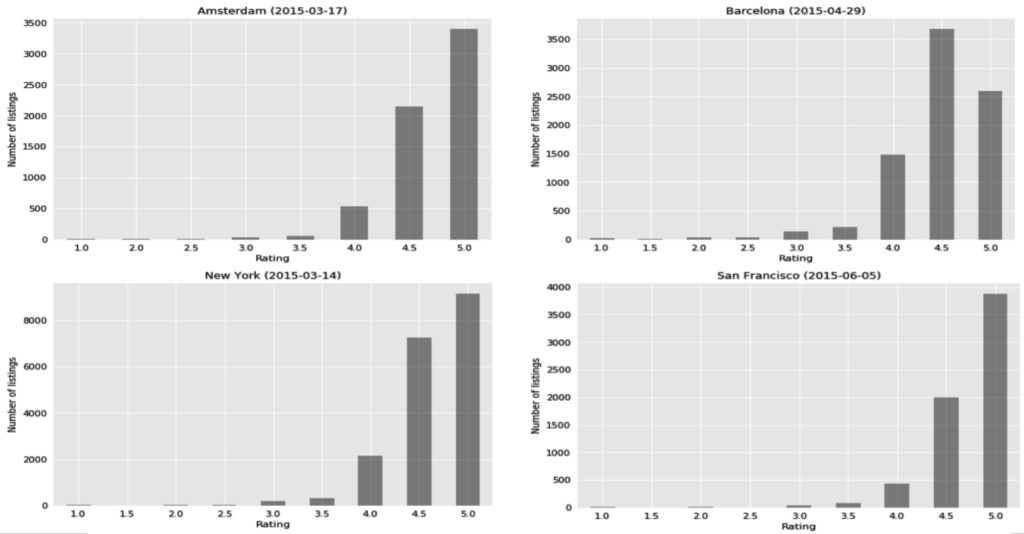
The Transitive Trust Network: How Trust Search Quantifies Interpersonal Trust
We’re All Connected by Just Six Degrees of Separation: The Power of Social Distance and Transitive Trust
TrustSearch.io is designed to provide insight into the trust relationships between users and allow users to make informed decisions in both the complex online ecosystem and day-to-day life. Trust, however, isn’t static — trust flows between individuals and groups.
How does TrustSearch quantify and incorporate the fluid nature of trust when assessing Trust Score and presenting trust data?
TrustSearch’s “Transitive Trust” feature is a unique solution to the problems presented by dynamic trust relationships.
Transitive Trust is a dynamic trust rating that provides Trust Search users with an easy to understand representation of the trust relationship between themselves and any other Trust Search profile. Unlike Trust Score, which functions as a static representation of the cumulative trust data of a user, Transitive Trust is a personalized assessment of the potential trust value between two specific users.
To achieve this, TrustSearch’s Transitive Trust feature builds on the “Small World Experiment.” All humans are connected by social networks, and are separated by a specific social distance — both of which can be used to calculate a personalised trust rating between users.

What is Social Distance?
There are almost eight billion people on the planet, but the world — in terms of social connections — is much smaller than we typically think.
The concept of “six degrees of separation” is the idea that all people are connected by a maximum of six social connections. Popularized by a 1993 film of the same name, the six degrees of separation dictates that there are only six small social jumps between you and any individual on earth.
Surprisingly, the six degrees of separation theory is backed up by a large amount of evidence. American psychologist Stanley Milgram’s 1973 “Small World Experiment” delivered the first empirical evidence to support a smaller social world, but more recent analyses of over 240 million online messenger users indicate that there are, in fact, only 6 social connections between any given user.
Anybody reading this article, for example, has a mutual friend or acquaintance that, in turn, has a mutual friend that is only a few additional connections away from Elon Musk — or Jack Ma, Kim Kardashian, David Beckham, or even the Queen of England. The social world is far smaller than we think.

Facebook publishes statistical data on social distance, revealing that the average social distance between two users is just 3.5 people — across 1.6 billion people, or roughly 22 percent of the global population.
How is social distance related to trust, though?
Social Distance and Trust
Psychological experiments reveal an important fact: social distance plays a critical role in how we assess the trustworthiness of others. A 2017 psychological experiment exploring the impact of social distance on trust indicates that trustors are far more likely to trust others in the presence of a mutual acquaintance — the presence of a mutually-known third party promotes trusting behavior between two strangers.
Earlier investigations into the impact of social distance on trust performed in 2011 found that trust is also influenced by locality and geographic distance. In a Cameroon-based experiment, inhabitants of specific communities participated in send-and-receive based trust games in which parties exchanged money with no assurance of receipt after sending. As expressed in the figure below, trust levels were far higher between individuals located within the same community:

In short, people are far more likely to trust others when they share clearly-defined social and geographic connections. Trust preference based on social connections, however, can have a restrictive impact on commerce. Social relationships can provide individuals with a means of verifying trust in others in lieu of market institutions, but can impede trust decisions — individuals are more likely to rely on abstract social preferences when attempting to predict the trustworthiness of others that aren’t present within their immediate social circle.
More than 87 percent of consumers make purchasing decisions based on the trust reputation of the brand, product, or service they are considering. As evidenced above, however, the trustworthiness of a product, service, brand, or individual can differ greatly depending on the social connections that link them.
This is where Transitive Trust becomes indispensable.
How Transitive Trust Works
To benefit from Transitive Trust, a Trust Search user must have a Trust Search profile, have created trust relationships by endorsing others, and must log in to their Trust Search account. TrustSearch allows users to endorse others through two functions: Empowered Trust, and Trust “Likes.”
- Empowered Trust
Function as strong Trust links between users and are not freely distributed in the same manner as simple Trust “likes”. Users forge Empowered Trust bonds with users that they trust deeply — Empowered Trust links make TrustSearch users the guarantors of each other’s Trust reputation. If the Trust reputation of a user decreases due to their bad actions, the Trust reputation of users they share Empowered Trust connections with are affected. - Trust “Likes”
Users can perform a simple trust endorsement that functions in a similar manner to the “like” function on Facebook — these Trust attributions are collected by users and contribute to their overall Trust Score to a small degree. It’s important to note that these “likes” aren’t reciprocal. A Trust Search user can trust and “like” a major brand, such as Nike, but this doesn’t create a trust relationship between the user and brand.
These two features create a network in which each user is connected to others via a spectrum of trust relationships. This “Trust Network” allows TrustSearch to calculate the “Trust distance” between users. This Trust distance is expressed as Transitive Trust.
Each TrustSearch user profile exists in a small circle of trusted connections and, to a lesser degree, profiles that they have endorsed with trust “likes.” These smaller networks exist in larger networks, defined as trust “circles.” When viewing other profiles, users are presented with a breakdown of how many trust circles separate them from the profile they are viewing, whether they share any mutual trust connections, and a highly accurate prediction of whether or not they are able to trust the profile in question.
It’s not necessary for a user to share an immediate trust network with another Trust Search profile in order to view the Transitive Trust between them. When calculating Transitive Trust values, Trust Search takes into account the social groups, interests, preferences, and habits of users and will create connections between similar profiles. This provides Trust Search users with natural relevancy that becomes progressively more accurate over time.
Identify Verification ≠ Trustworthiness
Trust is critical in the modern online ecosystem, especially when dealing with online marketplaces, trading platforms, or sharing economy apps such as Uber or AirBnB. These platforms typically ensure that users act in a trustworthy manner by capturing personal identity information in order to verify the personal details of users. User behaviour is then tracked via rating systems such as “star” ratings or a trustworthiness percentage rating.
A 2017 analysis of the self-regulation systems used within the sharing economy identifies “feedback loop failure” in typical star rating systems. Rating distribution in systems that don’t involve interpersonal interaction, such as Netflix, typically follow a bell curve expression — ratings congregate toward the middle, with few ratings either high or low.
The same study, however, found that the ratings of services that involve interpersonal interaction such as AirBnB or rideshare services are highly skewed toward a J-curve, primarily due to reciprocity bias, confirmation bias, and the herding effect.

While these systems are effective at measuring trustworthiness in a broad sense, they are subject to two major drawbacks in addition to user bias: the use of fake identity documentation, and inaccurate trust rating systems.
When using multiple platforms that require identity verification, users must upload identity documents to each individual platform and trust the platform itself to store their sensitive data in a secure manner. No identity verification procedure is flawless. Already-identified user accounts can be stolen by bad actors, or created with false identity documents. Identity fraud is a growing problem both online and offline, costing consumers over $14 billion dollars annually and resulting in more than 680,000 account takeovers every year.
While sharing economy platforms, marketplaces, and websites are able to minimize the impact of identity fraud, it’s not possible to determine whether an identified account has been taken over by a bad actor immediately.
Generalized rating systems such as the star rating system used on ride sharing apps are able to deliver a broad impression of the trustworthiness of a user, but fail to take into account the trust impact of interpersonal relationships and social distance or the recent actions of an account.
How Transitive Trust Creates Verifiable Trust
Transitive Trust, however, addresses these drawbacks. An individual seeking a particular product on an online marketplace, for example, is typically forced to make trust judgements on a seller based on their trading history on that platform alone.
Using TrustSearch, the same user is able to perform a search for the trader they’re considering purchasing an item from and assess the trust connections between them. A buyer is able to identify and trade with sellers that have positive trust relationships with other individuals within their own personal Transitive Trust network.
In addition to providing Transitive Trust insight into the relationship between a buyer and seller, Trust Search also provides Trust Trend data — a dynamic score created by analyzing the recent actions of an individual. These two data points allow Trust Search users to make an informed trust decision based on both the trust network connections they share with an individual and any recent actions that may affect their trustworthiness.
Importantly, Trust Search respects the privacy of users. Rather than act as a “big brother” system that tracks and shares the personal information of users, Trust Search secures the personally identifiable information it uses. This allows users to leverage the powerful trust assessment features of Transitive Trust and the Trust Search platform without placing their privacy at risk.
Transitive Trust Digitizes Word-Of-Mouth
Transitive Trust also provides expanded functionality to users seeking specialized services. There are many services and products that require specialized knowledge or expertise that can be difficult to identify in the current online environment. Similarly, there are many services that require a high level of trust between the buyer and the seller.
US-based American information, data and measurement firm Nielsen publishes interesting data on credibility and trust in the economy. When considering a new product or service, recommendations from friends are viewed by consumers as the most reliable and credible source of trust information. Nielsen survey data reveals that 83 percent of respondents across 60 different countries trust the recommendations of individuals in their immediate social circle over any other endorsement.
Asking for recommendations on any given service or product, however, can be time-consuming. Transitive Trust streamlines the recommendation process by mapping the trust preferences and recommendations of a user and providing a trust recommendation to them automatically, indirectly, and in many cases, anonymously. Trust Search users don’t need to directly ask their network for recommendations any more — Trust Search collects their recommendations and provides them to users with extremely high relevance and accuracy through Trust Search.
How does this system work in the real world, though?
Real-World Transitive Trust Use Cases
Transitive Trust isn’t a simple, static number expressed on Trust Search profiles. The ability to assess the trustworthiness and relevancy of a service or product based on the preferences of a user’s personal trust network has many real-world applications that deliver significant benefits.
An individual that has inadvertently locked themselves out of their home, for example, will require the services of a locksmith in order to have their locks changed and new keys created. Trust is critical when engaging locksmith services — locksmiths are trusted with literal keys to your home.
Using Trust Search, an individual is able to perform a search for local locksmiths in their area that have a high trust rating. Transitive Trust allows Trust Search users to identify and engage the services of locksmiths that have already created trust relationships with individuals in their trust network, providing them with access to services that offer a higher level of trust.
The applications of Transitive Trust aren’t limited to trust relationships and assessments, however. The trust networks created by Transitive Trust can also be used to identify services and products that are more relevant to users, or are better suited to personal preferences.
A Trust Search user will create a personal network of close friends and trusted parties through the Empowered Trust function. In most cases, this network will consist of other individuals that share similar preferences, habits, or locality.
A Trust Search user interested in starting a new fitness regime for a New Year’s resolution, for example, may want to find a local gym that aligns with their training preferences, schedule, and location. Trust Search’s Transitive Trust feature allows users to identify local gyms or fitness centers that are used and trusted by their personal network, providing personalized and relevant information.
Transitive Trust also delivers deeper insight into the variable nature of interpersonal trust in the work environment. Hiring new staff at a business can be a complicated process — it can be difficult to verify the information in a resume, for example. When hiring new staff, a business owner needs to ensure that new staff members are trustworthy and align with the goals and principles of their business.
Using Transitive Trust, a business owner or hiring manager can view the Transitive Trust value between themselves and potential employees, gaining actionable insight into whether the prospective hire is a good fit for their business or not.
The sharing economy provides a wide range of applications for Transitive Trust. AirBnB users are often presented with hundreds of different options for accommodation when on vacation or holidays. Using Transitive Trust, Trust Search users can view the properties and vacation stays that have been rented and given positive trust reviews by their personal network.
Transitive Trust Creates Unlimited Trust Opportunities
Determining who to trust and why requires a complex, difficult to define analysis of the history of an individual, their actions, the social networks they exist in, and much more. Trust Search quantifies and tracks trust, then calculates the potential trust between two parties via Transitive Trust.
Trust, in the current trust ecosystem, is highly centralized. Determining which news platforms to trust, which politicians are the most trustworthy, which brands provide quality services and products — all of these factors rely on trust delivered by vertical authority structures.
Transitive Trust decentralizes trust. If a user is not sure whether you can trust a political party to represent their interests, Transitive Trust provides insight into the potential trust relationship between them. Freelance workers, contractors, and businesses can assess the potential trust relationship between themselves and clients.
Potential employees can check the trustworthiness of a potential employer before they start working. It’s even possible to check the Transitive Trust value between two users that meet on an online dating app.
Ultimately, Transitive Trust opens the door to virtually unlimited possibilities in networking, relationships, business, and day-to-day life.
Key Takeaways
Transitive Trust isn’t a simple assessment of trustworthiness. In contrast with Trust Search’s Trust Score, which is an objective summary of the total trustworthiness of an individual across all platforms, Transitive Trust is a personal assessment of the potential trust relationship between two profiles.
Transitive Trust allows users to make more informed decisions on who to trust by leveraging the wisdom of their own personal network, as well as providing a faster, easier, and more effective method of identifying products, services, and people that meet their own personal preferences.
1: Grandjean Martin, « La connaissance est un réseau. Perspective sur l’organisation archivistique et encyclopédique », Les Cahiers du numérique, 2014/3 (Vol. 10), p. 37-54. DOI : 10.3166/LCN.10.3.37-54

